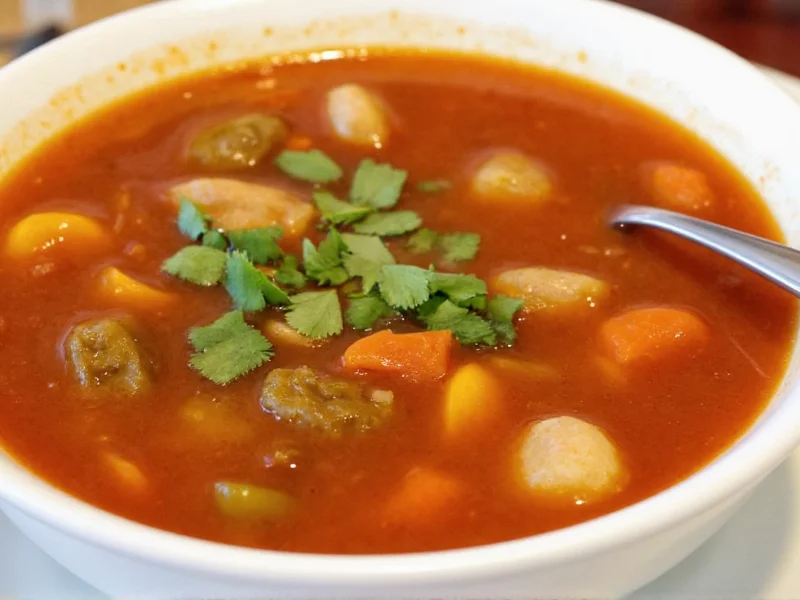Creating delicious homemade soup doesn't require professional culinary skills. Whether you're making chicken noodle, tomato basil, or vegetable soup, the fundamental techniques remain consistent. This guide breaks down the soup-making process into manageable steps anyone can follow, with professional tips to elevate your results from basic to exceptional.
Essential Components of Great Soup
Every successful soup contains these critical elements working in harmony. Understanding these components helps you troubleshoot and customize recipes to your taste preferences.
| Component | Purpose | Common Examples |
|---|---|---|
| Aromatics | Build flavor foundation | Onions, garlic, celery, carrots (mirepoix) |
| Liquid Base | Carries flavors and creates texture | Stock, broth, water, coconut milk, tomato juice |
| Main Ingredients | Provide substance and nutrition | Vegetables, meats, beans, grains, noodles |
| Seasonings | Enhance and balance flavors | Salt, pepper, herbs, spices, acids (vinegar, lemon) |
Step-by-Step Soup Making Process
Follow these steps to create restaurant-quality soup at home. This method works for nearly any soup variety and can be adapted based on your available ingredients and time constraints.
1. Prepare Your Ingredients (Mise en Place)
Before heating your pot, chop all vegetables to uniform sizes for even cooking. Measure liquids and have seasonings ready. This preparation prevents rushed cooking and ensures better flavor development. For most soups, aim for 1/2-inch dice on vegetables to maintain texture during simmering.
2. Build Flavor with Aromatics
Heat 1-2 tablespoons of oil or butter in a heavy-bottomed pot over medium heat. Add chopped onions, carrots, and celery (the classic mirepoix) and cook for 5-7 minutes until softened but not browned. Add garlic during the last minute to prevent burning. This foundational step creates the flavor base that permeates your entire soup.
3. Add Liquid and Main Ingredients
Pour in your chosen liquid base (4-6 cups for a standard pot), then add harder vegetables like potatoes or carrots that need longer cooking. Bring to a gentle simmer before adding more delicate ingredients. Never add all ingredients at once, as different components require varying cooking times.
4. Simmer for Flavor Development
Maintain a gentle simmer (small bubbles breaking the surface occasionally) rather than a rolling boil. Most vegetable-based soups need 20-30 minutes of simmering, while meat-based soups benefit from 45-90 minutes. Skim any foam that forms during the first 10 minutes for clearer broth. Remember that soup flavors continue developing after cooking, so avoid final seasoning until the end.
5. Final Seasoning and Finishing Touches
Before serving, adjust salt and pepper. Add finishing elements like fresh herbs, a splash of acid (lemon juice or vinegar), or a drizzle of quality olive oil. For creamier textures without dairy, blend a portion of the soup and return it to the pot. Let the soup rest for 5-10 minutes off heat before serving to allow flavors to marry.
Avoiding Common Soup-Making Mistakes
Even experienced cooks make these frequent errors that compromise soup quality. Recognizing these pitfalls helps you create consistently excellent results when you learn how to make soup from scratch.
- Adding salt too early - While you should season throughout cooking, save final salt adjustment until the end when flavors have concentrated
- Boiling instead of simmering - Vigorous boiling makes broth cloudy and can overcook delicate ingredients
- Overcrowding the pot - Too many ingredients prevent proper flavor development and even cooking
- Skipping the "taste as you go" step - Soup evolves during cooking; regular tasting ensures proper seasoning
- Adding all ingredients at once - Different components require different cooking times for optimal texture
Customizing Your Soup for Different Preferences
Once you master basic soup making techniques for beginners, you can easily adapt recipes to suit various dietary needs and flavor preferences. These modifications maintain the integrity of your soup while accommodating different requirements.
For vegetarian soup, substitute vegetable broth for meat-based stocks and add umami-rich ingredients like mushrooms, tomatoes, or soy sauce to compensate for missing meat flavors. To make gluten-free soup, use cornstarch or arrowroot as thickeners instead of flour, and verify that broths don't contain hidden gluten.
When creating low-sodium soup, build flavor with herbs, spices, citrus, and vinegar rather than salt. Add salt gradually at the end, or offer it at the table. For creamier textures without dairy, blend cooked potatoes, beans, or cauliflower into the soup instead of adding cream.
Proper Storage and Reheating Techniques
Soup often tastes better the next day as flavors continue to meld. Store cooled soup in airtight containers in the refrigerator for 3-4 days or freeze for up to 3 months. When reheating, do so gently over medium-low heat to preserve texture and prevent separation.
For best results when reheating frozen soup, thaw overnight in the refrigerator first. If soup has separated during storage, a quick whisk or brief simmer usually restores the proper consistency. Always bring reheated soup to 165°F (74°C) for food safety.
Troubleshooting Common Soup Issues
Even when following a simple vegetable soup recipe for beginners, problems can occur. Here's how to fix common issues:
- Soup is too thin - Simmer uncovered to reduce and concentrate, or create a slurry with cornstarch and water
- Soup is too thick - Gradually add more broth or water until desired consistency is reached
- Soup is bland - Add small increments of salt, acid (lemon/vinegar), or umami boosters like soy sauce
- Soup is too salty - Add raw potato slices to absorb excess salt, or dilute with unsalted broth
- Soup is greasy - Chill soup and skim solidified fat from the surface, or use an absorbent paper towel











 浙公网安备
33010002000092号
浙公网安备
33010002000092号 浙B2-20120091-4
浙B2-20120091-4